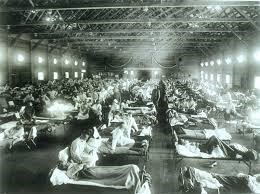
It is believed that the Spanish Flu or H1N1 Flu began at Camp Funston, a training camp for U. S. soldiers at Fort Riley, Kansas. In the first wave of the epidemic, most patients recovered. Such was not the case in later months of 1918. (en.wikipedia.org)
During the Civil War, both armies battled with disease as well as enemy fire. The numbers who died from non-combat causes was about 50%. Some fifty-five years later one disease infected over 500 million people or about one-third of the world’s population. Of those infected about 40 million died world-wide.
While Civil War doctors battled such common diseases as measles and chicken pox, doctors in World War I combated a new and extremely severe pandemic known as Spanish Flu or H1N1. In both cases, there were similarities. Men in all armies were seldom immune to such epidemics that would later be controlled by vaccines. The cramped and unsanitary conditions of war also contributed to spread of disease.
Spanish Flu or Flu as it became known as, first appeared at Camp Funston, a training camp located at Fort Riley, Kansas in the spring of 1918. Symptoms included chills, fever and fatigue but patients recovered relatively quickly.
However, influenza reared its ugly head with a vengeance in the fall of 1918. Usually the victims were within the age group of 20 to 40. The symptoms from the spring outbreak, now included lungs filled with fluids. In many cases death came within days or hours.
By winter of 1918 – 1919, another round appeared when the virus finally ran its course. No known origin can be found. As World War I dragged on and American troops arrived, governments became hesitant to report numbers of casualties from battles and disease. To do so, they believed, would reveal weaknesses to enemies.
Spain remained neutral during the war. When the flu arrived there, and infected the King of Spain, the disease became known as Spanish Influenza, even though it had infected most of the world by that time. Some doctors believed it started in China where a weak strain developed earlier in the year. But doctors had their hands full coping with the dreadful disease. Origin was not as important as preventing more deaths.
It should be noted that one-half of deaths of United States soldiers was caused by flu. On the home-front in America, the disease spread rapidly. Weddings and club meeting were postponed. Churches shuttered their doors and schools closed.
At first the U. S. Department of Health advocated fresh air as a cure. Restaurants taunted new sterilization techniques. Movie theaters required patrons to spread out among the empty seats and rows. Drug stores advertised numerous remedies, mostly based on alcohol. Soon most public gathering places either voluntarily or by force closed.
Orphaned children were sent to live with distant relatives. Hospitals were overcrowded. There was a shortage of coffins. Attendance at funerals was discourage; only close family members attended services limited to fifteen minutes.
Newspapers were filled with despair. One man in north Texas who worked at a ship building plant in Virginia, and was believed to have the flu, was sent home on a train. He died on the train less that fifty miles from home. Soldiers stepping off trains suddenly collapsed on the platform.
In one northeast Texas county, a small rural school chose to erect a pole on which to fly a large American flag. In order to pay for the flag and pole, the community planned for a play while the mass closure of schools was in effect. How many were infected is unknown.
Just as quickly as the epidemic appeared, it disappeared in the winter months of 1919. Not too soon, though. An estimated 675,000 Americans died, equivalent to the number who died in the Civil War.
